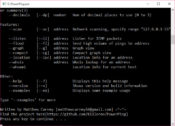- Review
PowerPing is a powerful and enhanced alternative to the traditional ping utility, designed to provide users with more detailed insights into network connectivity and performance. Built with advanced features and ease of use in mind, this tool allows users to troubleshoot network issues, monitor latency, and visualize packet loss more effectively than standard utilities.
Whether you’re a system administrator, IT professional, or network enthusiast, PowerPing delivers the tools you need to analyze and optimize your network. Below, we explore its key functionalities, advantages, limitations, and address common questions about its usage.
Advanced ping functionality
At its core, PowerPing enhances the traditional ping command by offering additional diagnostic capabilities. It provides real-time insights into packet transmission, latency, and packet loss, helping users identify connectivity issues quickly.
The software supports customizable packet sizes, intervals, and timeouts, allowing users to tailor tests to their specific needs. These features make it ideal for pinpointing network bottlenecks, measuring performance over time, or testing the reliability of remote servers.
Visualization and reporting
One of the standout features of PowerPing is its ability to visualize network performance. The tool includes graphical displays of latency and packet loss, making it easier to interpret results at a glance.
Additionally, the software supports logging and exporting test results, allowing users to generate detailed reports for further analysis or collaboration with team members. This feature is particularly useful for documenting issues or tracking performance improvements over time.
Real-time monitoring
PowerPing includes a continuous monitoring mode, enabling users to observe network performance in real time. This feature is valuable for detecting intermittent issues or monitoring a connection’s stability over an extended period.
The tool also offers alert options, notifying users of significant changes in latency or packet loss, ensuring they can respond promptly to potential problems.
Lightweight and portable
Designed to be lightweight and portable, PowerPing runs efficiently on most systems without requiring installation. This makes it an excellent tool for on-the-go diagnostics or quick deployment across multiple devices. Its minimal resource usage ensures it won’t interfere with other network activities or strain system performance.
Advantages
- Provides enhanced ping functionality with detailed diagnostic options.
- Supports customizable tests, including packet size, interval, and timeout adjustments.
- Includes graphical visualization of network performance for easier analysis.
- Offers real-time monitoring and alerts to detect issues promptly.
Limitations
- Lacks advanced network tools like traceroute or bandwidth analysis.
- May require some familiarity with networking concepts for full utilization.
- Visualization features might not display optimally on lower-resolution screens.
Frequently Asked Questions
1. What is the primary purpose of PowerPing?
This tool is designed to provide enhanced network diagnostics, including advanced ping tests, real-time monitoring, and graphical performance visualization.
2. Does PowerPing support real-time monitoring?
Yes, it offers continuous monitoring to track network stability and performance over time, with optional alerts for significant changes.
3. Can I customize ping tests with this tool?
Absolutely. It supports adjustments for packet size, intervals, timeouts, and more to tailor tests to your needs.
4. Does PowerPing generate reports?
Yes, the software includes logging and export options to create detailed reports for analysis or documentation purposes.
Conclusion
PowerPing is a versatile and powerful utility that builds on the standard ping tool with advanced diagnostic features, visualization capabilities, and real-time monitoring. Its lightweight design and portability make it an ideal choice for network troubleshooting and performance optimization.
While it focuses primarily on ping-related diagnostics and lacks broader network tools, PowerPing excels at what it does, offering detailed insights and customizability for network analysis.
Whether you’re troubleshooting connectivity issues, monitoring a server’s performance, or documenting network behavior, PowerPing is a reliable and effective tool for the job.


